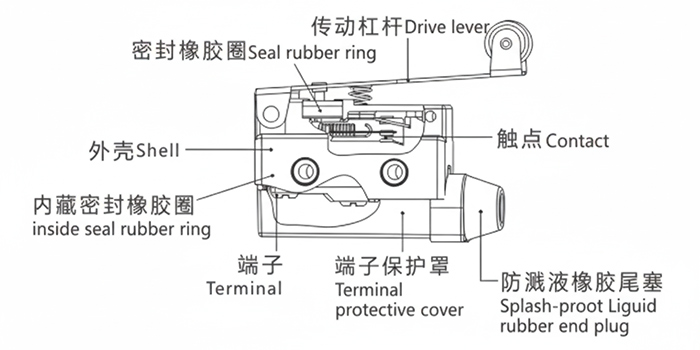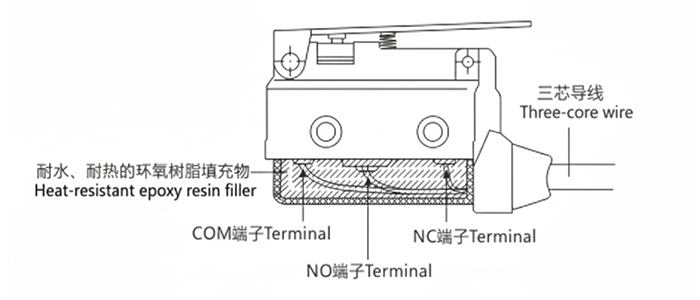In harsh operating environments such as industrial automation, automotive electronics, and outdoor equipment, the environmental resistance of Micro Switches directly determines the reliability and safety of the entire system. Water, dust, oil, and chemicals are “invisible killers” that lead to contact failure and mechanical wear. Therefore, it is crucial to understand and correctly select micro switches with the appropriate Ingress Protection (IP) Rating and sealing technology to ensure high reliability while maximizing cost-effectiveness.
Introduction: Challenges and Protection Needs in Harsh Environments
Micro switch failure modes are complex and varied, but in severe environments, the core challenges can be summarized into three areas that directly threaten the switch’s electrical performance, mechanical life, and structural integrity:
1. Electrical Degradation: High Impedance and Contact Failure
Moisture Impact: Once humid air or condensation penetrates the switch interior, it forms a water film on the contact surface. This water film dissolves contaminants, accelerating the oxidation and sulfidation of contact materials (like silver), leading to a rapid increase in contact resistance. In low-current/low-load circuits, this high impedance can directly cause a “contact failure” signal loss.
Conductive Particles: Conductive dust (such as metal shavings or carbon powder) entering the contact area can cause momentary short circuits or accelerate contact surface wear. During high-load switching operations, these contaminants may trigger micro-arcing, leading to contact erosion (Arc Erosion), forming insulating oxides, and further deteriorating contact quality and reliability.
2. Mechanical Failure: Wear and Sticking
Increased Friction: Fine grit or non-conductive dust are common abrasives. They adhere to the precise mechanisms inside the switch, such as operation springs, levers, or plungers, significantly increasing friction between moving parts. This can alter the switch’s Operating Force or Travel, pushing it outside design specifications.
Fluid Erosion: In applications like CNC machine tools and hydraulic equipment, cutting fluids, oil, or solvent vapors may penetrate. These fluids wash away existing internal lubricants, accelerating metal wear; or they chemically react with plastic and rubber components, causing seals to age or swell, ultimately leading to actuator sticking and mechanical failure.
3. Structural Integrity and Insulation Breakdown
Material Aging and Cold Flow: Harsh environments affect not only metal but also sealing and housing materials. Prolonged exposure to high temperatures, UV light (outdoor applications), or chemical vapors can cause the switch’s plastic housing and rubber seals to become brittle, soften, or shrink. Under continuous stress, sealing materials may exhibit Cold Flow, leading to permanent failure of their sealing performance.
Insulation Breakdown: Internal moisture or contamination not only affects contacts but also reduces the dielectric strength of the switch’s internal insulating materials (like insulating barriers or housing). In high-voltage applications, decreased insulation performance can lead to leakage or even Electrical Breakdown, causing equipment failure or safety incidents.
To address these challenges, the industry uses the IP (Ingress Protection) rating system based on the IEC 60529 standard as a unified measure of a switch’s environmental resistance, supplemented by various sealing technologies for enhanced protection.
Decoding the IP Code: Universal Protection Ratings for Micro Switches
The IP rating consists of two digits (e.g., IP65). The first digit represents the rating against solid foreign objects (dust), and the second digit represents the rating against water. Understanding these numbers is the first step in correct selection.
The table below details common IP ratings in the micro switch field and their protection commitments:
| IP Code | Dust Protection (1st Digit) | Water Protection (2nd Digit) | Protection Commitment (Key Application Environments) |
|---|---|---|---|
| IP54 | 5 (Dust Protected) | 4 (Splashing Water) | Protected against most dust ingress (not fully dust-tight) and resistant to splashing water from any direction. Suitable for indoor humid or light industrial environments. |
| IP65 | 6 (Dust-Tight) | 5 (Water Jet) | Resistant to low-pressure water jets from any direction, and completely prevents dust ingress. Suitable for rain exposure and low-pressure cleaning environments. |
| IP66 | 6 (Dust-Tight) | 6 (Powerful Water Jet) | Resistant to high-pressure or powerful water jets from any direction. Commonly used in industrial or marine environments requiring heavy washdowns. |
| IP67 | 6 (Dust-Tight) | 7 (Temporary Immersion) | Prevents water ingress under specified pressure and time conditions (typically 1 meter depth for 30 minutes). Suitable for applications that may encounter brief flooding. |
| IP68 | 6 (Dust-Tight) | 8 (Continuous Immersion) | Manufacturer specifies stricter conditions for continuous immersion, suitable for long-term underwater or high-water-pressure applications. |
| IP69K | 6 (Dust-Tight) | 9K (High Pressure/Temp) | Resistant to steam-jet cleaning or high-pressure, high-temperature washdowns. Primarily used in food processing, pharmaceutical, or automotive engine bay deep cleaning. |
Core Distinction: IPX5 (Water Jet) and IPX7 (Immersion) are the two most commonly used levels for micro switches, representing a critical leap from “splash-proof” to “submersible.”
Protection Levels in Practice: Scenario-Based Applications
In practical procurement, higher protection ratings often mean higher costs. Therefore, selecting switches based on the severity of the actual environment is the best strategy to balance cost and reliability.
2.1. High-Level Sealing (IP67/IP68): For Immersion and High-Pressure Washdown
This level of switch offers the highest dust and water resistance and is ideal for ensuring critical task execution.
Protection Characteristics: Dust-Tight (IP6X) and resistant to temporary or continuous immersion (IPX7/IPX8). Selection Reference: Waterproof switch series compliant with IP67 or IP68 standards. Applicable Scenarios: Charging gun locking mechanisms for new energy vehicles, joints of industrial robotic arms, outdoor security equipment, and food processing machinery requiring regular high-pressure cleaning.
2.2. Mid-Level Protection (IP65): For Rain and Humidity
This level is suitable for applications that need to withstand external weather elements but will not be fully submerged.
Protection Characteristics: Dust-Tight (IP6X) and resistant to water jets (IPX5). Selection Reference: Sealed switches compliant with IP65 standards. Applicable Scenarios: Control modules for large household appliances, control panels for agricultural machinery, semi-outdoor equipment, or devices at risk of condensation.
2.3. Structural Sealing (Encapsulated): For Oil and Dust
For many industrial devices, the primary threat is not water immersion but oil mist and particulates. The focus of these switches is structural sealing to provide resistance against industrial fluids.
Protection Characteristics: Offers basic dust protection (e.g., IP5X or IP6X) and splash resistance (e.g., IPX4), primarily focused on effectively blocking oil and cutting fluids. Selection Reference: Typical encapsulated or limit switches, usually featuring reinforced mechanical sealing designs. Applicable Scenarios: CNC machine tools, stamping presses, and within automated production lines (areas with significant oil mist and chips).

Manufacturing Processes and Inspection of Micro Switch IP Ratings
The achievement and effectiveness of an IP rating depend on the manufacturer’s structural design and the user’s strict procurement inspection.
3.1. Key Sealing Technology Analysis (Engineering Implementation Methods)
These technologies are the foundation for micro switches to achieve IP67/IP68 ratings:
O-Ring Sealing: Use of elastomer O-rings or gaskets at active components such as the switch housing, actuator shaft, and lead-out holes. This is the most cost-effective sealing method, but its reliability is affected by material quality and assembly precision, and it may fail under long-term use or extreme temperature fluctuations. Epoxy Potting: Completely filling and encapsulating the internal circuitry and lead connections of the switch with epoxy resin or other insulating sealants. This is one of the most reliable methods for achieving IP67/IP68 ratings, effectively preventing moisture penetration from the leads, but it increases the switch size and cost, and usually prevents repair after potting. Ultrasonic/Laser Welding Encapsulation: A specialized process used to melt the upper and lower housing or seal the casing joints together, forming a seamless connection. This effectively prevents the entry of liquids and gases. This form of encapsulation provides excellent structural strength and sealing consistency.
3.2. Key Selection Considerations and Effectiveness Inspection (Procurement and Specification Details)
When procuring from a micro switch supplier, simply viewing the IP certification is not enough. The following details will determine the long-term reliability of the switch:
Lead Exit Point Treatment: This is the most common point of failure. For IP67 switches, confirm that the leads are not simply passed through the housing but are sealed via potting or molding. Poor potting may develop cracks under temperature changes. Actuator Shaft Sealing: Check whether the operating lever (such as a roller or plunger) entering the housing is equipped with a silicone dust boot or rubber bellows. Sealing of moving parts is crucial, as it directly affects the switch’s mechanical life and consistency of the operating force. Certification and Reports: Request detailed IP test reports to ensure the product is certified by a third-party laboratory, not merely self-declared. For structurally sealed products, focus on their resistance reports for oil/cutting fluids. Also, understand whether the switch’s electrical life has been tested in humid environments to ensure comprehensive protection.

Conclusion: Environmental Protection and Economic Efficiency
The sealing solution of a micro switch is the cornerstone of system reliability, but its value is not reflected solely in the IP numbers but in the accuracy of the engineering decision.
A successful protection strategy requires engineers to accurately assess the primary threat in the application environment (Is it continuous immersion, or high-temperature, high-pressure washdowns?), and find the optimal balance among IP65, IP67, and IP69K. Blindly pursuing the highest rating often leads to unnecessary cost escalation and increased size, especially if the environment only requires IP65 protection.
In selection, one must always be vigilant against the most common causes of IP rating failure: sealing defects at the lead exit point and aging of the actuator shaft seal. Therefore, attention to these critical sealing structures and process details is far more important than the IP number on the housing itself.
Only by deeply understanding the sealing technology principles and failure modes behind the IP code can the IP rating be elevated from a simple numerical label to a reliable engineering selection decision, ultimately achieving the optimal match between environmental adaptability and cost-effectiveness.

